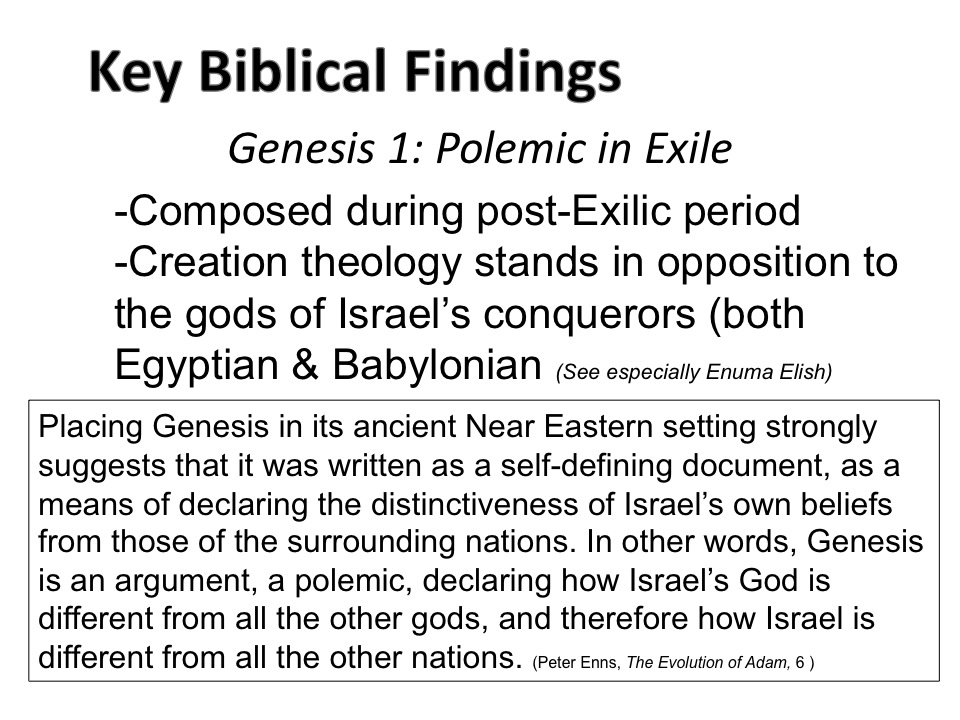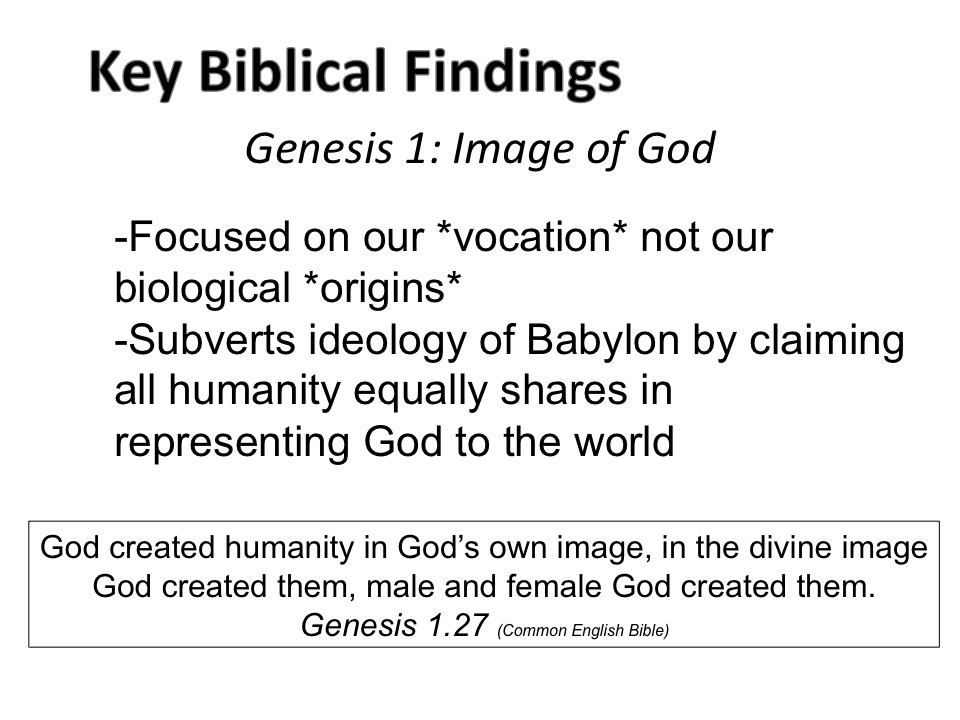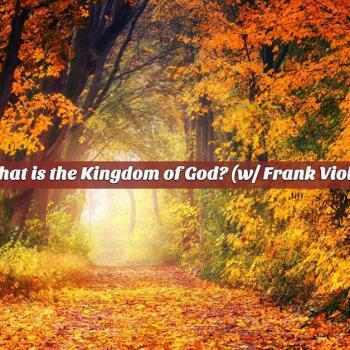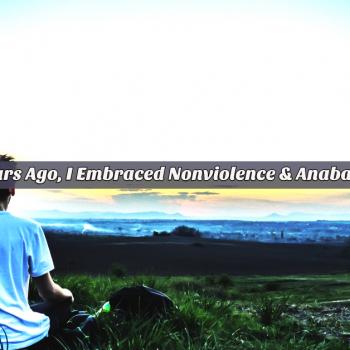The following series is based on my senior paper for Seminary. You may remember a video where I invited people to contribute their stories to help make my case. For the next couple weeks, I’ve decided to share my findings with you all. There will be a “thesis/problem” section, a “biblical theology” section, and an “application” section. I hope you will read along and share this with others! You can read the rest of the series here.
—————————————————————————————
Evolving Evangelicalism: Inviting Church Leaders to Refine their Approach to Scripture and Origins (part 5)
Occasion for Writing Genesis 1
In order to understand the author’s intent in Genesis 1, examining the original historical context will prove helpful. Although well-meaning evangelical apologists have written much to the contrary,[1] the entire book of Genesis did not come into its final form until the post-exilic age.[2] Genesis 1, the first creation narrative, is the relatively newer text (composed by the Priestly redactor [“P”]) addressing issues arising from the exilic / post-exilic period, and Genesis 2-3, the second creation narrative, finds its roots well before the exile (“J” source). For “P,” one purpose was to address the despair of God’s people who were divided, pillaged, and forced out of their land. The text provides a reflection on God as the creative organizer of the cosmos within a historically disorienting set of circumstances.
The two creation accounts ought to be read as two distinct stories.[3] These texts with “different origins and transmission histories” were intentionally “brought together in a coherent way by a redactor” to complementarily “provide the canonical picture of creation.”[4]
Polemical Nature of the Text
Genesis 1 functions as a polemic against the gods of Israel’s exilic conquerors. To accomplish this end, the liturgy utilizes older narratives about the creation of the cosmos from Israel’s neighbors. Elements of Egyptian and Mesopotamian stories find their way into the biblical text, but are deliberately subverted.[5] Genesis 1 provides a central interpretive concern, from which the creation theology finds its proper rooting. In order to make meaning out of their experiences with God in the midst of exile, Genesis 1 refutes the theology of 6th century Babylon by reminding Israel that God alone brings life and order to humanity and the earth.[6] Peter Enns states this well:
Placing Genesis in its ancient Near Eastern setting strongly suggests that it was written as a self-defining document, as a means of declaring the distinctiveness of Israel’s own beliefs from those of the surrounding nations. In other words, Genesis is an argument, a polemic, declaring how Israel’s God is different from all the other gods, and therefore how Israel is different from all the other nations.[7]
God’s Liberating Image
The climax of Genesis 1, seen here, concerns humanity: “So God created human beings in his own image, in the image of God he created them…” (Genesis 1.27). Many conflicts regarding biological evolution stem from this passage, because the common assumption is that humankind is unique. This is true, but our uniqueness is in our vocation, not in our biological origins. To make this point, it will be helpful to consider this verse in the context of the ancient world.
In the context of the passage, Brueggemann states: “It is now generally agreed that the image of God reflected in the human persons is after the manner of a king who establishes statues of himself to assert his sovereign rule where the king himself cannot be present.”[8] Placing tangible physical images in regions where the ruler could not be present served to remind the subjects of the identity of their ruler.
A key difference in Genesis is that the kingly language does not refer to iron-fisted dominance. Rather, this is a subversion of Mesopotamian ideology. J. Richard Middleton writes, “But whereas power in the Babylonian and Assyrian empires was concentrated in the hands of a few, power in Genesis 1 is diffused or shared.”[9] In God’s economy, humanity is “called to a fundamental mutuality in a shared task,”[10] involving the stewarding of God’s creation project. Therefore, the “image of God” ultimately describes the egalitarian role of imaging God to all the earth, and as such, endows all humankind with intrinsic value, thus liberating humanity from the oppressive values of empire.[11]
Chaos and Enuma Elish
Of the texts that Genesis 1 appropriates and subverts, Enuma Elish stands out as a key to comparison (which dates back at least to the 7th century BCE [pre-exile], but may have traditions reaching back to the 3rd millennium BCE). Enuma Elish makes us acutely aware of the theology of Babylonian peoples during the exilic period, which Israel’s creation theology intentionally countered.[12] Enuma Elish tells the story of the victorious god Marduk, who during a cosmic battle kills his great-great-grandmother, the goddess Tiamot. Then, Marduk separates her dead body into two pieces; one half becomes the heavens and the other half forms the earth.
There is a rhetorical connection between Genesis 1 and this Babylonian epic. Where Tiamot personifies chaos that must be tamed (through violence), Israelite theology deliberately depersonalizes chaos as “the deep” (Hebraic “tehom” with linguistic ties to the word Tiamot). God alone tames the dark chaos without the use of violence,[13] and is too powerful to consider a conflict with lesser deities from surrounding pagan nations.[14]
[1]. See: Josh McDowell, The New Evidence That Demands a Verdict, rev., updated, and expanded ed. (Nashville: Thomas Nelson, 1999), ch. 13-21. He argues for the Mosaic authorship of the whole Pentateuch.
[2]. Brueggemann, Genesis, 16.
[3]. Ibid., 14.
[4]. Fretheim, The New Interpreter’s Bible: A Commentary in Twelve Volumes – Volume I, 340.
[5]. Brueggemann, Genesis, 24.
[6]. Ibid., 25.
[7]. Peter Enns, The Evolution of Adam: What the Bible Does and Doesn’t Say about Human Origins (Grand Rapids, MI: Brazos Press, 2012), 6.
[8]. Brueggemann, Genesis, 32.
[9]. J. Richard Middleton, The Liberating Image: The Imago Dei in Genesis 1 (Grand Rapids: Brazos Press, 2005), 204.
[10]. Ibid., 205.
[11]. Ibid., 204-5.
[12]. Conceptual similarities between the two stories include: darkness and chaos precede creation, light exists prior to the sun, depiction of a method for keeping the waters separated above the earth, a sequence of creation days followed by rest, and connections to temples (a point that will be explored below).
[13]. Enns, The Evolution of Adam: What the Bible Does and Doesn’t Say about Human Origins, 38-41.
[14]. Raymond Van Leeuwen, “1343,” in New International Dictionary of Old Testament Theology & Exegesis, ed. Willem A. VanGemeren (Grand Rapids: Zondervan Pub. House, 1997), 729.













